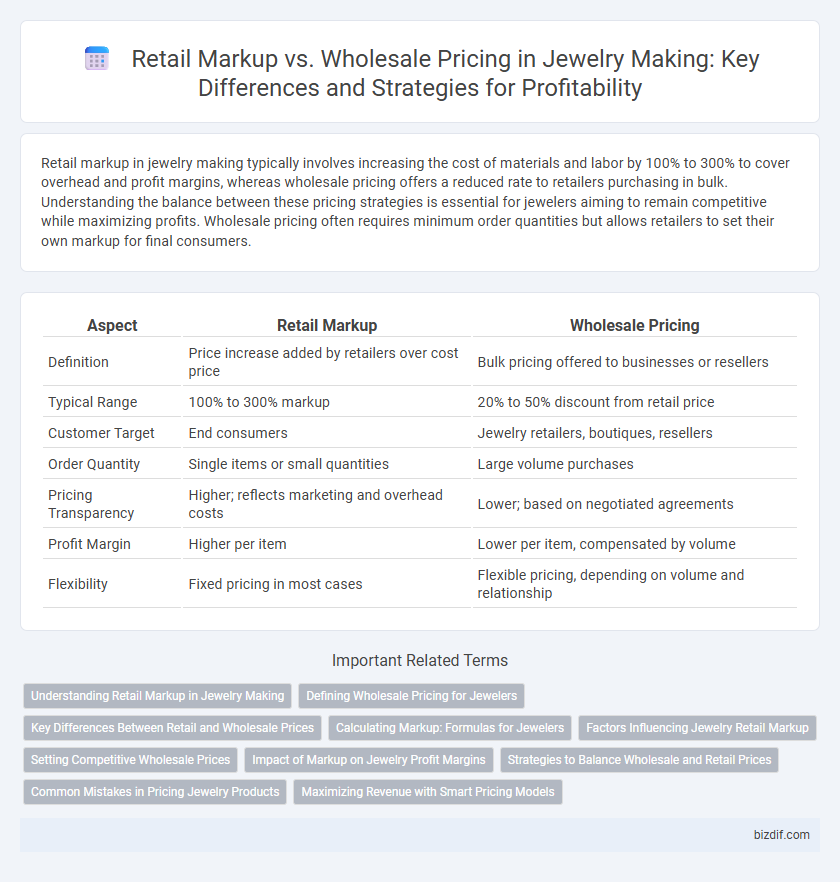Retail markup in jewelry making typically involves increasing the cost of materials and labor by 100% to 300% to cover overhead and profit margins, whereas wholesale pricing offers a reduced rate to retailers purchasing in bulk. Understanding the balance between these pricing strategies is essential for jewelers aiming to remain competitive while maximizing profits. Wholesale pricing often requires minimum order quantities but allows retailers to set their own markup for final consumers.
Table of Comparison
| Aspect | Retail Markup | Wholesale Pricing |
|---|---|---|
| Definition | Price increase added by retailers over cost price | Bulk pricing offered to businesses or resellers |
| Typical Range | 100% to 300% markup | 20% to 50% discount from retail price |
| Customer Target | End consumers | Jewelry retailers, boutiques, resellers |
| Order Quantity | Single items or small quantities | Large volume purchases |
| Pricing Transparency | Higher; reflects marketing and overhead costs | Lower; based on negotiated agreements |
| Profit Margin | Higher per item | Lower per item, compensated by volume |
| Flexibility | Fixed pricing in most cases | Flexible pricing, depending on volume and relationship |
Understanding Retail Markup in Jewelry Making
Retail markup in jewelry making typically ranges from 100% to 300%, reflecting the significant added value for craftsmanship, branding, and retail overhead. Understanding wholesale pricing involves recognizing the base cost of materials and labor, often marked up by 50% to 100% for retailers. Accurate markup strategies ensure profitability while maintaining competitive pricing in a market driven by quality, design uniqueness, and consumer demand.
Defining Wholesale Pricing for Jewelers
Wholesale pricing for jewelers typically involves selling jewelry pieces in bulk at a lower cost per unit compared to retail prices, allowing retailers to achieve significant profit margins through markup. This pricing strategy is essential for jewelers to manage inventory turnover efficiently while maintaining competitive pricing for retailers. Understanding wholesale price structures enables jewelers to set realistic production costs and optimize their supply chain for scalable business growth.
Key Differences Between Retail and Wholesale Prices
Retail markup typically ranges from 100% to 300%, reflecting added costs like marketing, display, and customer service, whereas wholesale pricing is set lower to accommodate bulk purchasing and reseller profit margins. Wholesale prices are negotiated according to quantity, directly impacting per-unit cost efficiency, while retail prices target end consumers with fixed margins to maximize profitability per individual sale. Understanding these key differences helps jewelers strategically price products to balance competitive pricing and sustainable profit.
Calculating Markup: Formulas for Jewelers
Jewelers calculate retail markup by applying a percentage to the wholesale cost, commonly using the formula: Retail Price = Wholesale Cost x (1 + Markup Percentage). Understanding the difference between markup and margin is crucial; markup is based on cost, while margin is based on selling price. Accurate markup calculation ensures profits cover expenses, account for market demand, and position jewelry competitively in retail pricing.
Factors Influencing Jewelry Retail Markup
Jewelry retail markup is primarily influenced by factors such as material costs, including precious metals and gemstones, and labor intensity involved in crafting each piece. Market demand fluctuations and brand positioning also play crucial roles in determining markup percentages, often ranging from 100% to 300% above wholesale pricing. Overhead expenses, including store operations, marketing, and customer service, further impact the final retail price set by jewelers.
Setting Competitive Wholesale Prices
Setting competitive wholesale prices in jewelry making requires analyzing production costs, including materials like gold, silver, and gemstones, alongside labor expenses and market demand. Wholesale pricing typically ranges from 50% to 70% of the retail markup, ensuring retailers can maintain profitable margins while offering attractive prices to customers. Accurate cost calculation and industry benchmarking enable artisans to establish prices that drive volume sales and sustain long-term business growth.
Impact of Markup on Jewelry Profit Margins
Retail markup significantly influences jewelry profit margins by increasing the final selling price beyond wholesale costs, often ranging from 2x to 3x. Wholesale pricing provides lower unit costs, enabling jewelers to maintain competitive pricing while achieving sustainable profits. Understanding the balance between markup and wholesale price is essential to maximize revenue without deterring customers.
Strategies to Balance Wholesale and Retail Prices
Balancing wholesale and retail prices in jewelry making requires strategic markup decisions that highlight craftsmanship while maintaining competitive pricing. Retail markup typically ranges between 100% to 300%, reflecting costs, labor, and desired profit margins, whereas wholesale pricing targets bulk buyers with lower rates for volume sales. Implementing tiered pricing, offering exclusive designs for retail customers, and fostering strong relationships with retailers can optimize profitability and market reach.
Common Mistakes in Pricing Jewelry Products
Retail markup in jewelry often exceeds wholesale pricing by 100% or more, but common mistakes include neglecting material costs and labor intensity, leading to undervaluation. Artisans frequently overlook competitive market analysis, resulting in prices that either scare away customers or erode profit margins. Accurate pricing demands balancing intrinsic value, design complexity, and current market trends to sustain long-term business viability.
Maximizing Revenue with Smart Pricing Models
Retail markup in jewelry making typically ranges between 100% to 300%, enabling artisans to cover costs and generate profit, whereas wholesale pricing offers lower margins but higher volume sales. Smart pricing models balance these approaches by analyzing customer segments, market demand, and competitor pricing to optimize revenue. Leveraging data-driven strategies such as dynamic pricing and tiered discounts maximizes profitability while maintaining competitive advantage in both retail and wholesale channels.
Retail markup vs Wholesale pricing Infographic

 bizdif.com
bizdif.com